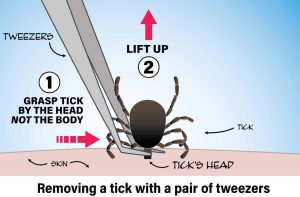If you think ticks are a concern only in the deep woods, it’s time to think again. Partially due to migrating deer populations, ticks are now abundant in suburban and city backyards – and they’re spreading disease. As a result, an estimated 476,000 Americans are infected with Lyme disease each year, according to estimates from the Centers for Disease Control and Prevention.
Tick exposure can occur year-round, but ticks are most active during warmer months (April-September). Know which ticks are most common in your area.
If you find a tick attached to your skin, remove the tick as soon as possible. Several tick removal devices are on the market, but a plain set of fine-tipped tweezers works well.
How to remove a tick
- Use clean, fine-tipped tweezers to grasp the tick as close to the skin’s surface as possible.
- Pull upward with steady, even pressure. Don’t twist or jerk the tick; this can cause the mouth parts to break off and remain in the skin. However, if this happens, remove the mouth parts with tweezers. Otherwise, if you cannot remove the mouth easily with tweezers, leave it alone and let the skin heal.
- After removing the tick, thoroughly clean the bite area and your hands with rubbing alcohol, soap, and water.
- Never crush a tick with your fingers. Dispose of a live tick by
- Putting it in alcohol,
- Placing it in a sealed bag/container,
- Wrapping it tightly in tape, or flush it down the toilet.
If symptoms occur, please consult with a provider to check for tickborne illnesses
Many tickborne diseases can have similar signs and symptoms. Additionally, if you get a tick bite and develop the symptoms below within a few weeks, see your healthcare provider. The most common symptoms of tick-related illnesses include:
- Fever/chills. All tick-borne diseases can cause fever.
- Aches and pains. Tickborne diseases can cause headaches, fatigue, joint pain,n and muscle aches.
- Rash. Lyme disease, Southern tick-associated rash illness (STARI), Rocky Mountain spotted fever (RMSF), ehrlichiosis, and tularemia can cause distinctive rashes.
Reviewed by Tomah Health Infection Prevention Team: 12/17/2024

